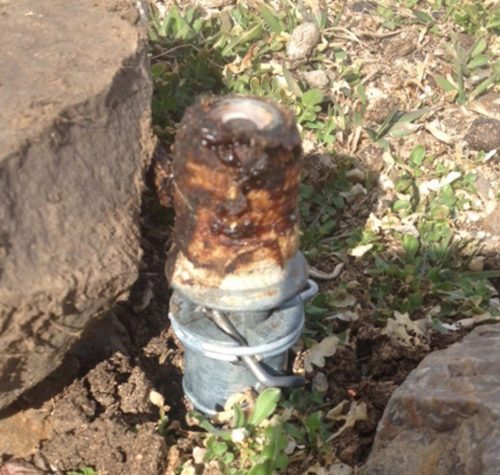“Grimm” Prospects for Idaho’s Predators
2nd of Aug 2017

Wildlife Services recently held a series of meetings in Idaho to “educate” the public on its use of cyanide bombs to kill coyotes at the behest of ranchers. Here is our take on the Boise meeting:
If Idaho Wildlife Services’ goal with its recent series of meetings – held in Lewiston, Boise and Pocatello – was to bore the public to death while sneaking in its intention to continue using M-44s on private lands, their plan was a total success.
Based on Idaho Wildlife Services director Todd Grimm’s weak presentation, backed by the presence of regional director Jason Suckow, it’s clear that the real purpose was to roll out Wildlife Services’ new rules about M-44 use so they can start deploying them on private lands in Idaho again.
Wildlife Services stopped using M-44s in Idaho – which the agency deploys upon request by ranchers to kill “problem” coyotes, feral dogs and foxes – after the so-called “incident” in March when Pocatello teen Canyon Mansfield watched helplessly as his dog Kasey died after the two discovered a cyanide bomb on BLM land near his home. Canyon was also exposed to the deadly poison and still suffers from side effects. You can read Canyon’s personal account of this horrific day here.

Wildlife Services claims it temporarily ceased using M-44s throughout the country after Kasey’s death, although it has since resumed business as usual in every state but Idaho.
In Idaho, Wildlife Services granted a petition from environmental groups, led by longtime Advocates for the West client Western Watersheds Project, to ban M-44s in the state until further notice. Wildlife Services claims the ban will remain in effect until the agency has completed its secret internal investigation into the “incident.” Once that is complete, Grimm and company will consider once again deploying M-44s on private lands only. Given the content of the presentation, the outcome of their consideration seems a foregone conclusion – the archaic and deadly devices will once again lurk on private lands, presenting a hidden hazard to members of the public and their pets.
During his powerpoint presentation, Mr. Grimm made several attempts to downplay the use of M-44s – including a slide stating that cyanide is a naturally occurring substance found in lima beans, almonds, apricot pits and other plant matters (which most of us likely recall learning in elementary science class). Until this point, the crowd of about 25 had been fairly quiet – asking just a few follow-up questions throughout. But this slide quelled our collective patience.
“Give me a break. Why is this relevant?” One Great Old Broads for Wilderness member called out. With that, the dam broke, everyone laughed and shouted in agreement, and the remainder of the presentation was peppered with intense questioning. No one was rude, but we were very, very persistent.
Despite the hopelessly dry presentation, which was devoid of any real information, our questioning revealed some interesting facts:
• As much as 80% of Idaho Wildlife Services’ budget goes to “agricultural protection” – primarily to “address” predation on livestock.
• Idaho lands host approximately 500,000 head of cattle each year (according to this chart, coyotes killed just 39 cows and 120 sheep in Idaho in 2016; Wildlife Services killed 3,850 coyotes last year).
• Of the thousands of coyotes killed last year, just 53 were poisoned with M-44s. This begs the question – why put the public, our pets and non-target wildlife at grave risk for so little?
• 809 M-44s have been detonated in Idaho between 2011-15.
• All M-44s deployed in the United States are manufactured by, and shipped from, the Pocatello Supply Depot in southern Idaho.
• The Idaho Wildlife Services office apparently uses an “analytical thought process” – which it does not document – to determine which method of predator control to use.
• As far as Wildlife Services knows, the United States is the only country that uses sodium cyanide to kill wildlife.
Perhaps the most important question of the evening came from Canyon’s older sister, Madison Mansfield: “Was 53 coyotes worth killing my family’s dog and endangering the life of my brother?”
Grimm mumbled his reply after a painfully long pause: “You won’t like my answer.”
If Wildlife Services is looking to gain the trust of Idaho communities after being thrust into the scrutinizing public eye as a result of Kasey’s death and the Mansfield family’s suffering, this secretive federal agency is failing miserably.
To find out what happened at the Pocatello meeting, read WWP Executive Director Erik Molvar’s op-ed in the Idaho State Tribune – Wildlife Services fails to win any converts. As we’d hoped, the residents of this close-knit community were all fired up to support the Mansfield family and demand that Wildlife Services improve its behavior.

